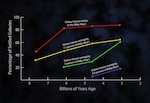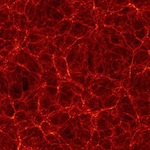Word doc
PDF (formatted and ready to go as a single newsletter page)
‘Smoking Gun’ for Stellar Explosion Mystery
Some stars end their lives in cataclysmic explosions: spectacular supernovae, which briefly become the most brilliant objects in their home galaxies, visible from millions or even billions of light-years away. Supernovae are of several distinct types, as is evident from their spectra—the graphs astronomers plot showing the distribution of colors of the supernova light.
One major category is core-collapse supernovae, where a very massive star becomes unstable and explodes. The most mysterious of these are known as Type IIb. Theory and computational simulations suggested that some may be stars that have entered the Wolf-Rayet phase of their final existence.
In Wolf-Rayet stars—behemoths over 20 times as massive as our Sun and at least five times as hot—nuclear reactions have produced carbon, oxygen, and heavier chemical elements. Some of these elements are mixed to the surface and help produce powerful winds that shed part of the star’s outer layers into space. After the Wolf-Rayet star’s core turns to iron, evidence suggested that protons and electrons merge and the core collapses, releasing a flood of energy and neutrinos, and powering a shock wave that explodes the star. But until recently, no definitive observations confirmed that hypothesis, in part because dense clouds of stellar winds often obscure Wolf-Rayet stars.
Thanks to the intermediate Palomar Transient Factory (iPTF) pipeline, however, the definitive answer came on May 3, 2013, illuminated in a brilliant flash of ultraviolet light from a supernova dubbed SN 2013cu, in a galaxy 360 million light-years away in the constellation Boötes.
Fast discovery pipeline
The iPTF is a computatinally beefier upgrade to the original Palomar Transient Factory (PTF) launched in 2008, which contributed to the enormously productive field of time-domain astronomy by catching supernovae within hours after their initial light reaches Earth. Atop Palomar Mountain in southern California, the 1.2-meter Samuel Oschin Telescope acts as an automated wide-field survey camera, snapping sequential exposures of 7 square degrees across the night sky. Every minute, its sensitive 96-megapixel CCD camera records stars and galaxies down to 21st magnitude, 2.5 million times fainter than the human eye can see.
Each digital image is instantly beamed to the San Diego Supercomputing Center at UC San Diego, and then 400+ miles north to the National Energy Research Scientific Computing Center (NERSC) at Lawrence Berkeley National Laboratory (LBNL). Within minutes, supercomputers subtract reference images from each incoming image, comparing new sources of light to all public databases to tag known variable stars and asteroids. Every night, on average, iPTF discovers one to two new supernovae.
Caught in the act
Less than 30 minutes after images are taken, coordinates of suspected supernovae are sent to astronomers worldwide. The iPTF alert triggered researchers at the Weizmann Institute of Science to capture a spectrum with the 10-m Keck-I telescope only 10 hours after SN 2013cu was first imaged, just 15.5 hours after light from the explosion reached Earth.
“Shortly after the star exploded, an ultraviolet flash from the shock wave heated and lit up the wind,” explained Peter Nugent, head of the Computational Cosmology Center at LBNL and a coauthor of the study. The UV flash was brilliant enough for the iPTF team to analyze the wind’s chemical makeup—which revealed the composition of the star before it exploded, confirming it to be similar to that of a Wolf-Rayet star.
“This is the smoking gun!” Nugent exulted. “For the first time, we can directly point to an observation and say that this type of Wolf-Rayet star leads to this kind of Type IIb supernova.”
“We are gradually determining which kinds of stars explode, and why, and what kinds of elements they produce,” added coauthor Alex Filippenko, professor of astronomy at UC Berkeley. “These elements are crucial to the existence of life—so we are figuring out our own stellar origins.” –Trudy E. Bell, M.A.
Further reading: “A Wolf-Rayet–like progenitor of supernova SN 2013cu from spectral observations of a wind,” appeared in Nature, May 22, 2014, http://dx.doi.org/10.1038/nature13304. The LBNL press release is at http://1.usa.gov/1kumFjt. More on PTF is at http://bit.ly/VM5Fv5l.
The University of California High-Performance AstroComputing Center (UC-HIPACC), based at the University of California, Santa Cruz, is a consortium of nine University of California campuses and three Department of Energy laboratories (Lawrence Berkeley Laboratory, Lawrence Livermore Laboratory, and Los Alamos National Laboratory). UC-HiPACC fosters collaborations among researchers at the various sites by offering travel and other grants, co-sponsoring conferences, and drawing attention to the world-class resources for computational astronomy within the University of California system. More information appears at http://hipacc.ucsc.edu .





















